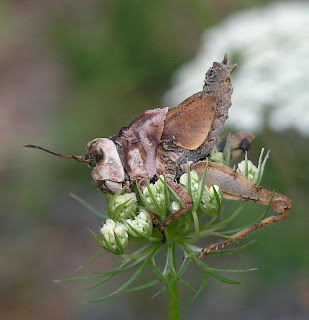.
Late June and early July of 2007 were warm (typical) and wet (atypical). One result of these warm and moist conditions was a fungi population boom. I don't know if I've ever seen so many mushrooms on the forest floor and alongside the road. Another result was a lot of dead grasshoppers. As it turned out, a fungus was also responsible for killing the grasshoppers.
.
As I understand it, the grasshopper killing fungal spores are always present, but under the right warm and moist conditions, they too experience a population boom and corresponding increase in the rate of grasshopper mortality. I've noticed maybe a half dozen grasshoppers in the typical fungal death pose this past summer. In 2007, I'd see four or five per day.
.
An interesting aspect of the grasshopper fungus is that as it multiplies within the hopper's body, the fungal infection causes the grasshopper to climb as far as it can get toward the top of a plant stem or stalk where it holds on tenaciously even after death. Fungal spores are released as the dead grasshopper's body decomposes. Being high on a stem or stalks helps the wind borne spores spread over a wider area.
.
.




